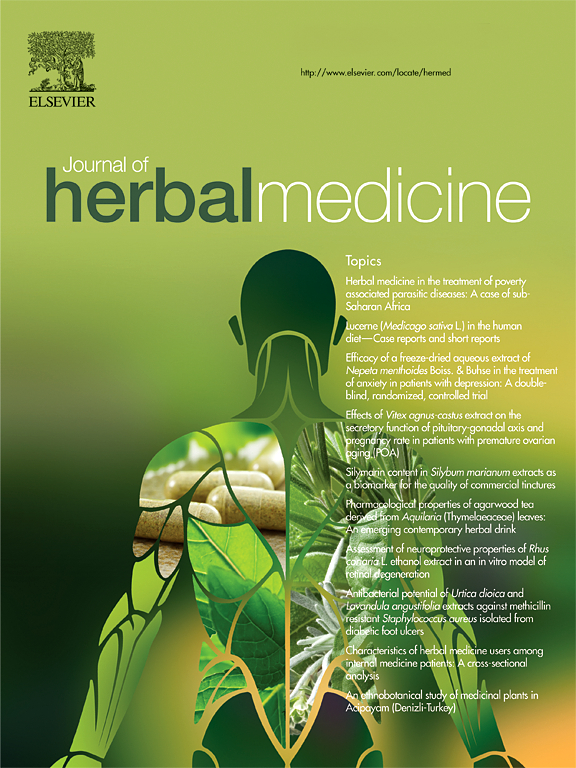马尾草乳膏治疗妊娠纹未产妇女会阴创伤的安全性和有效性评价:一项随机对照临床试验
IF 1.9
4区 医学
Q2 INTEGRATIVE & COMPLEMENTARY MEDICINE
引用次数: 0
摘要
会阴创伤(PT)在分娩过程中很常见,它会影响妇女的健康。由于皮肤弹性差,患有妊娠纹(SG)的女性患PT的风险更大。木贼草含有有效的化合物,增加皮肤弹性,因为它的胶原蛋白的生产和结缔组织的加强。本研究旨在确定木贼乳膏(EAC)对未产SG妇女PT率的影响。方法对2020-2021年在马什哈德产前门诊就诊的63例中、重度SG未生育妇女进行临床试验研究。这些人被分为干预组和安慰剂组。从37-38周开始直到分娩,参与者每晚用3% EAC或安慰剂涂抹会阴和阴道。分娩后测量会阴撕裂或会阴切开术的程度、长度和深度。结果干预组的会阴切开术率明显低于安慰剂组(27.3% vs. 56.7%, p = 0.018)。干预组会阴完整、黏膜划伤、一、二度撕裂率分别为29.2%、37.5%、33.3%、0.0%,安慰剂组为15.4%、30.8%、23.1%、30.8% (p = 0.037)。干预组会阴切开和破裂的平均长度和深度低于安慰剂组(p <;0.05)。结论seac可有效减少会阴创伤。因此,建议在怀孕期间使用EAC作为一种有效且简单的草药方法来预防PT。本文章由计算机程序翻译,如有差异,请以英文原文为准。
Evaluation of the Safety and Efficacy of Equisetum arvense Cream on Perineal Trauma in Nulliparous Women With Striae Gravidarum: A Randomised Controlled Clinical Trial
Introduction
Perineal Trauma (PT) is common during childbirth, and it affects women's health. Women with Striae Gravidarum (SG) are at greater risk for PT due to poor skin elasticity. Equisetum arvense has effective compounds that increase skin elasticity due to its collagen production and strengthening of connective tissue. This study aimed to determine the effect of Equisetum arvense cream (EAC) on the rate of PT in nulliparous women with SG.
Methods
The present clinical trial study was conducted on 63 nulliparous women with moderate and severe SG who visited the prenatal clinics of Mashhad in 2020-2021. The individuals were assigned to the intervention and placebo groups. The participants smeared the perineum and vagina with a knuckle of 3% EAC or placebo every night, from the beginning of 37-38 weeks until delivery. After delivery, the degree, length, and depth of perineal laceration or episiotomy were measured.
Results
The rate of episiotomy was significantly lower in the intervention group than in the placebo group (27.3% vs. 56.7%, p = 0.018). The rates of intact perineum, mucosal scratch, first and second degree tears were 29.2%, 37.5%, 33.3% and 0.0% in the intervention group, and 15.4%, 30.8%, 23.1% and 30.8% in the placebo group, respectively (p = 0.037). The mean length and depth of episiotomy and rupture were lower in the intervention group than in the placebo group (p < 0.05).
Conclusions
EAC was effective in reducing perineal trauma. Therefore, the use of EAC during pregnancy is recommended as an effective and uncomplicated herbal approach to prevent PT.
求助全文
通过发布文献求助,成功后即可免费获取论文全文。
去求助
来源期刊

Journal of Herbal Medicine
INTEGRATIVE & COMPLEMENTARY MEDICINE-
CiteScore
3.90
自引率
0.00%
发文量
94
期刊介绍:
The Journal of Herbal Medicine, the official journal of the National Institute of Medical Herbalists, is a peer reviewed journal which aims to serve its readers as an authoritative resource on the profession and practice of herbal medicine. The content areas of the journal reflect the interests of Medical Herbalists and other health professionals interested in the clinical and professional application of botanical medicines. The objective is to strengthen the research and educational base of herbal medicine with research papers in the form of case studies, original research articles and reviews, monographs, clinical trials and relevant in vitro studies. It also publishes policy statements, opinion pieces, book reviews, conference proceedings and profession related information such as pharmacovigilance reports providing an information source for not only the Herbal Practitioner but any Health professional with an interest in phytotherapy.
 求助内容:
求助内容: 应助结果提醒方式:
应助结果提醒方式:


